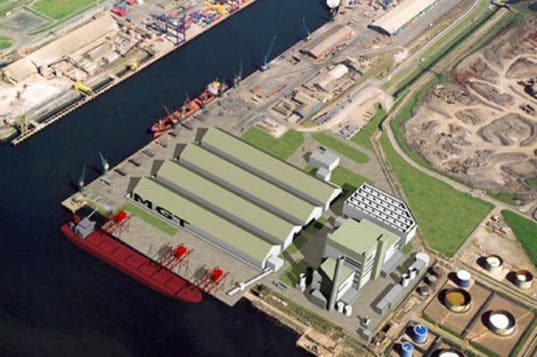The United Kingdom has announced plans to build the world’s largest biomass powerplant. The Tees Renewable Energy Plant (REP) will be located in the Port of Teesside, Middlesbrough and it will have a capacity of 299 MW. While the plant is designed to be able to function on a wide range of biofuels, its main intended power sources are wood pellets and chips, of which the plant is expected to use more than 2.4mt a year. The feedstock will be sourced from certified sustainable forestry projects developed by the MGT team and partners in North and South America, and the Baltic States, and supplied to the project site by means of ships.

Image via power-technology
A biomass power plant of this type is referred to as a combined heat and power (or CHP) plant. It will generate enough renewable energy to supply its own operations and commercial and residential utility customers in the area.
Investment in the renewable project is estimated to reach £650m ($1bn), which will be partly funded through aids from the European Commission, and construction works would create around 1,100 jobs. Environmental technology firm Abengoa, based in Spain, along with Japanese industry giant Toshiba will be leading the project for their client, MGT Teesside, subsidiary to the British utility MGT Power.
The feedstock will be burned to generate steam at 565°C that will drive a steam turbine, which will rotate the generator to produce electricity. The generated power will be conveyed to the National Grid.The exhaust steam generated by the steam turbine plant will be condensed by the ACCs and re-used, whereas the flue gases from the CFB boiler will be discharged via the exhaust stack.
Nitrogen dioxide (NO2) emissions will be minimized by using capture technology, fabric filters will reduce emission of particulate matter or dust and check the sulphur content of the fuel feed, while sulphur dioxide (SO2) emissions will be reduced through limestone injection into the boiler.

Image via inhabitat
The energy output of the plant is anticipated to be equivalent to the power consumed by 600,000 households in the UK. MGT’s website says the plant will help meet the UK’s nationwide renewable energy goal of 15 percent of all energy consumed by 2020 by accounting for around 1 percent of the target. Further, the company projects that the plant will save approximately 1.2 million tonnes of CO2 each year.
MGT reports the project is expected to break ground as soon as funding is secured, hopefully by early 2016, and the plant will be operational by 2019 – just in time to help offset coal and gas usage and contribute to the UK’s 2020 energy goals.
Was this helpful?



